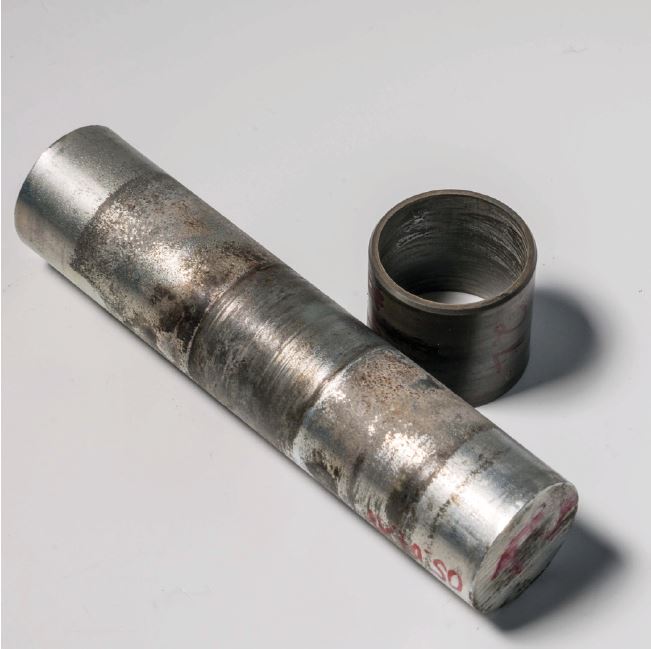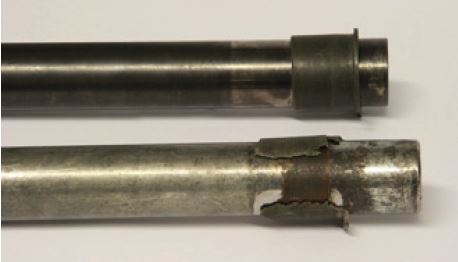Shaft coating: nitride or galvanise?
Lars Butenschön | 30. April 2020
The number of plain bearing solutions is virtually infinite, and there are no fewer designs of suitable – and unsuitable – shaft materials. In fact, different shaft materials and their coatings can create completely different wear patterns for the same plain bearing. This blog entry will deal with two frequently used shaft coatings and consider the question of which shaft coating is better suited to polymer plain bearings: nitrided or galvanised.
Shaft galvanisation
In galvanising, workpieces are immersed not in a zinc melt, but in a zinc electrolyte. The workpiece to be galvanised is suspended in the solution as a cathode. An electrode of zinc that is as pure as possible is used as the anode. In galvanising, the zinc coating is proportional to the strength and duration of the current flow, and depending on the geometry of the workpiece, the coating is distributed over the entire workpiece. This galvanising process has a number of advantages.
It creates pure, uniform, and therefore corrosion-resistant, easily chromatable coatings. The layer thicknesses can be calibrated precisely, saving metal. There is no need to rework threads, fitting points, etc. The base material is not exposed to heat, so there is no deformation. The actual corrosion protection develops during galvanising via the passivation of the zinc layer. With regard to the effects of galvanising on the special requirements of the shaft-bush connection and shaft wear, the negative ones predominate.

The actual galvanised shaft coating is relatively soft. The coating passivation (“white rust”) also creates a comparatively rough surface. The protective layer is worn relatively quickly, removing corrosion protection in the bearing’s contact area. At the same time, the coefficient of friction increases. This happens with both metallic and polymer plain bearings. In most cases, corrosion protection can be maintained only if the bearing point is supplied with grease.
Nitriding: gas nitriding and nitrocarburisation
Nitriding is also divided into two methods:
gas nitriding and nitrocarburisation. During gas nitriding, nitrogen diffuses into the components in a split ammonia gas atmosphere, usually at 500-530°C. Long treatment periods (10 to 160 hours) result in nitriding hardness depths (Nht) of 0.1-0.9mm, depending on the material used. The main objectives are enhancing component strength, wear resistance, sliding properties, temperature resistance, and flexural fatigue strength. Gas nitriding also allows partial
treatment of the material.
In nitrocarburisation, a nitrocarburising treatment is performed at 560-580°C. In addition to nitrogen, carbon diffuses into the material. Treatment time is usually 1-5 hours, and cooling is performed, depending on material, in a water or molten salt bath. The nitriding hardness depth is approximately 0.25mm (depending on material). The treatment is mainly for wear and corrosion protection. The process can take place either in a salt bath (salt bath nitrocarburising) or ammonia gas (gas nitrocarburisation). The current trend is towards gas nitrocarburising. #
Nitriding has many positive characteristics. It can be used on almost all steels. It leads to a hard surface with a soft core. There is little warpage in the material, since no structural change takes place. Fatigue strength and wear and corrosion behaviour improve. Bulk material can be treated, and partial nitriding is possible. Post-oxidation after nitrocarburising can further improve corrosion resistance. In conjunction with maintenance-free iglidur plain bearings, whose self-lubricating properties allow dry operation (without external lubrication with greases or oils), both nitriding methods are recommended for corrosion protection and reduced wear.
Shaft coating comparison: galvanise or nitride?
In general, nitrite-treated shafts are significantly better counter partners for iglidur materials than those of untreated raw materials. A major advantage over galvanised finishes is that no coating is applied. Instead, the actual shaft material is modified via nitrogen and carbon diffusion. This means that, depending on diffusion depth, surface damage cannot reduce the corrosion protection level. The differences have been demonstrated in a comparative test.

Both bearings were used in the same machine under identical conditions (pivoting movement, high forces, edge loads, dirt). We used the iglidur G gliding bearing material in both cases. An identical design of ST52 shaft was used with galvanising and gas nitriding. The galvanised version clearly shows that the protective zinc coating is completely worn away in the bearing’s contact area. Corrosion protection is lost. There is massive shaft corrosion. A dramatic increase in the coefficient of friction results. Bearing destruction is not due to wear in the tribological sense. Instead, the material is literally torn apart by shear stress. This effect was not observed with the nitrocarburised shaft version.
We would be happy to help you select the right shaft-bearing combination.
Are you looking for the right shaft for your plain bearing? Or do you need a shaft, too? Do you have questions about coatings on shafts for plain bearings? We will help you design your plain bearing system, serving as a single-source provider. We will be happy to provide you with expert advice, free of charge and without obligation, digitally or by telephone.

